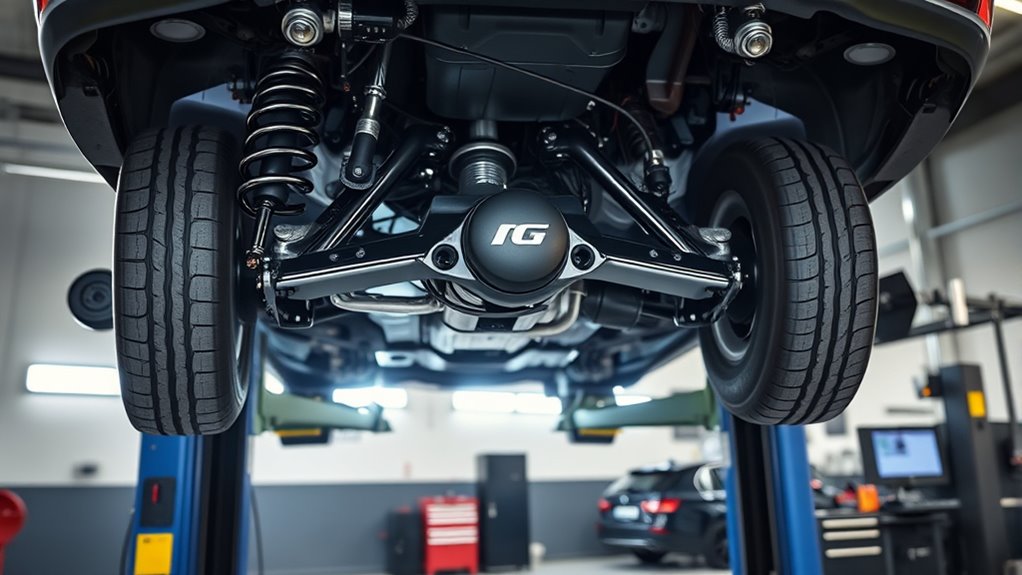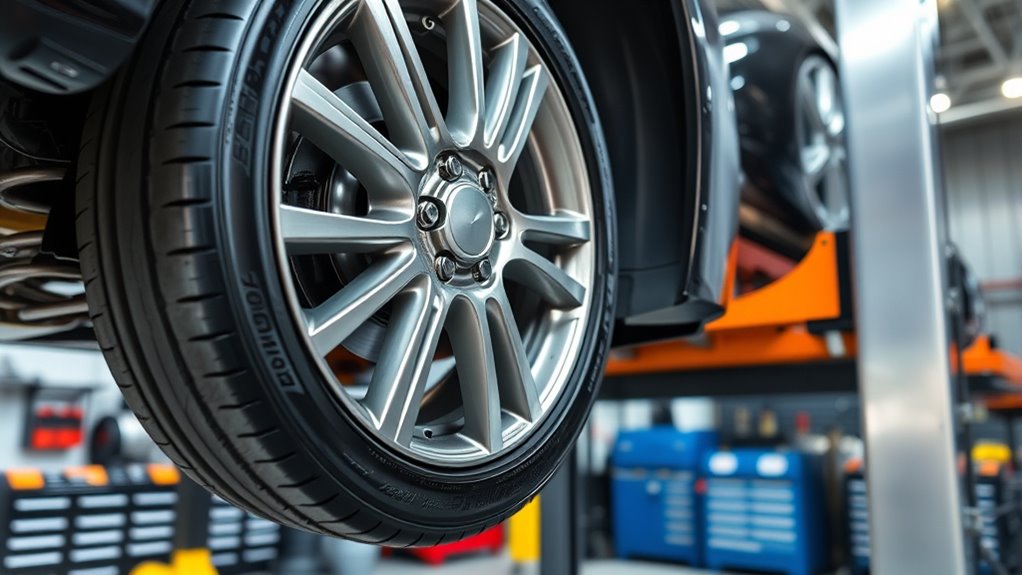Most service plans for alignments and suspension cover essential checks and necessary adjustments, including wheel alignments to correct angles and suspension component inspections like shocks and struts. They often include wheel balancing to prevent uneven tire wear and vibrations, plus replacement if needed. Regular maintenance helps improve handling, extend tire life, and ensure vehicle safety. To find out exactly what your plan covers and how it benefits your vehicle, keep exploring your options.
Key Takeaways
- Most service plans include wheel alignment to ensure proper angles and improve handling.
- Suspension inspections and shock absorber checks are commonly covered to maintain ride quality.
- Regular adjustments and replacements of worn suspension components are often included in maintenance plans.
- Tire balancing and rotation services are frequently part of comprehensive alignment and suspension packages.
- Service plans help prevent uneven tire wear, vibrations, and suspension-related issues by regular monitoring and servicing.

Ever wondered how your vehicle stays stable and handles smoothly on the road? The answer often lies in proper alignments and suspension maintenance. When your car’s suspension system is in good shape, it absorbs bumps, maintains tire contact, and keeps your ride comfortable. One essential aspect of this is regular wheel balancing and ensuring your shock absorbers are functioning correctly. Proper wheel balancing prevents uneven tire wear and vibrations that can compromise steering accuracy, while shock absorbers control the bouncing motion of your suspension, providing stability and comfort. When these components are neglected, your vehicle can feel unstable, and your tires may wear out prematurely.
A good service plan typically covers wheel alignments and suspension inspections, but many also include checks or replacements of shock absorbers. These components are indispensable because they dampen the impact from potholes and rough terrain, helping you maintain control. When shock absorbers wear out, you might notice increased body roll, nose-diving during braking, or a rougher ride. In such cases, your service plan would likely include replacing them to restore proper handling. Similarly, wheel balancing is often part of regular maintenance, especially if you notice vibrations at higher speeds or uneven tire wear. Properly balanced wheels ensure that your tires rotate evenly, reducing strain on suspension parts and extending tire life.
Many service plans also cover alignment services, which are essential for correct steering and tire longevity. Misaligned wheels can cause uneven tire wear, poor fuel efficiency, and a less predictable driving experience. During an alignment, technicians adjust the angles of your wheels to match the manufacturer’s specifications, which improves handling and extends the lifespan of your tires and suspension parts. Well-maintained suspension components, such as shocks and struts, contribute significantly to vehicle stability and ride quality. When combined with regular suspension checks, including shock absorber evaluations, your vehicle remains more stable, responsive, and safe on the road.
Frequently Asked Questions
How Often Should I Get My Alignment Checked?
You should get your alignment checked at least once every 12,000 miles or when you notice uneven tire wear or your car pulling to one side. During these checks, wheel balancing and tire rotation are also important to maintain smooth handling and extend tire life. Regular inspections help catch issues early, saving you money and ensuring safety on the road. Don’t wait too long—stay proactive with your vehicle maintenance.
Are Suspension Repairs Covered Under Warranty?
Suspension repairs are often covered under warranty, but don’t count your chickens before they hatch. Most warranties have exclusions and coverage limits, so it’s essential to read the fine print. Typically, if your suspension issue stems from a manufacturing defect, it’s covered. However, damage from accidents or neglect usually isn’t. Always check your warranty details to know what’s included and what’s not before heading to the shop.
What Are Signs My Suspension Needs Service?
If you notice your vehicle’s spring wear or experience steering issues like pulling to one side or a loose feel, your suspension likely needs service. Other signs include uneven tire wear, a bumpy ride, or your vehicle sagging. Don’t overlook these symptoms, as they can affect your safety and handling. Schedule a suspension check promptly to prevent further damage and ensure smooth, safe driving.
How Long Does an Alignment Typically Take?
An alignment usually takes about an hour, like a well-orchestrated symphony. During this time, a technician performs a wheel alignment and suspension adjustment to make certain your vehicle tracks straight and handles smoothly. The process involves fine-tuning the angles of your wheels to manufacturer specifications, enhancing safety and tire longevity. Keep in mind that some vehicles or issues might extend the time, but generally, an hour is enough for a thorough job.
Does Insurance Cover Suspension Repairs?
Insurance usually doesn’t cover suspension repairs unless it’s due to an accident or specific damage. You’ll need to pay out-of-pocket for repairs like tire balancing or steering adjustments. If your suspension issues are from regular wear and tear, check with your provider first, but generally, these repairs fall under maintenance rather than insurance coverage. It’s best to review your policy or talk to your mechanic for clarity.
Conclusion
When you get your alignments and suspension covered by your service plan, you’re practically invincible on the road! No more worries about worn-out parts or sudden steering mishaps—your car becomes unstoppable, like a superhero in disguise. With the right coverage, you’ll drive with the confidence of a race car driver, knowing your vehicle’s health is protected from every pothole, bump, or rogue pebble. It’s not just maintenance; it’s your car’s secret armor!









